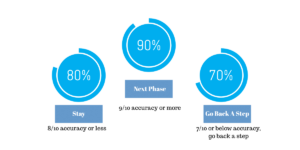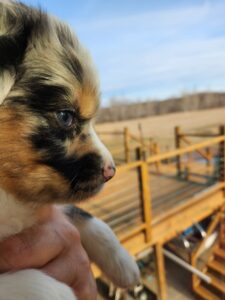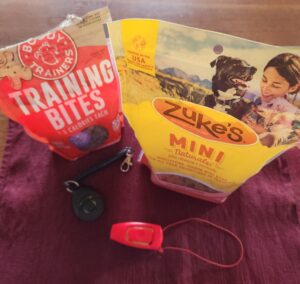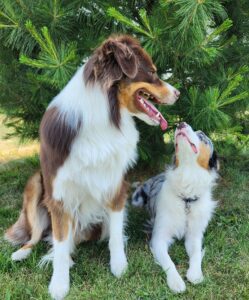To train effectively, you need to pick a technique that works efficiently for the given behavior. These techniques include luring, shaping, and capturing. Once the dog knows what you want him to do, you need the dog to be able to perform when asked, do it consistently, and in a wide range of environments by learning about the concepts of distance, duration, distraction, and generalization.
Luring
Luring is one of the easiest and fastest ways to get a dog into a particular position. A dog will follow a treat that you place right in front of their nose. By moving it in a specific direction, like toward the floor or over the dog’s ears, the dog will automatically move into a desired position. Think of moving your dog as if they had a string attached to their nose—how would you need to move that string to get your dog into a sit or a down?
With each repetition of the same movement, the dog will gradually start to anticipate and understand how to get the treat and will get into position faster. When you lure a dog a few times into position, you make getting into that position more likely to happen again. However, it is important to quickly stop luring the dog and give him the opportunity to complete the behavior without hand movement. Many behaviors can be jump-started with luring and repeated four to six times but should then transition to capturing or shaping for more efficient training sessions.
Capturing
Dogs will naturally get into different positions without your help. If you mark any behavior with a click or a “Yes!” and then reward the dog, with repetitions, the dog will start offering that behavior more often. As the dog starts the movement, you can then pair it with a specific cue. This is how you can capture behaviors that can range from a simple Sit to less typical behaviors such as Shake Off or Speak.
Shaping
Shaping is one of the most powerful training methods available. Think about breaking down a behavior into very small steps. The behavior Down, for instance, starts with the lowering of the dog’s body. If you click (or say “Yes!”) and treat any time the dog looks down, lowers his head, or lowers his rump, he will gradually start lowering his body on purpose to get the treat. As you progress, you can increase your criteria, marking only when he moves closer to the desired behavior. Step by step, you can shape the dog into position.
Adding the Cue
Most behaviors will be taught without talking to the dog first. If the dog has no idea what you’re expecting, talking will not help. Be patient and let your dog think about how to get the reward. Once the dog has figured out what to do, then you can add the cue. Teaching a dog is like teaching a foreign language—it takes repetition (50 to 100 times) for a word to be associated with the right behavior. Get the behavior first, then associate it with the corresponding cue.
Duration
Positional behaviors such as Sit, Down, or Stand require a certain duration. That means when you ask the dog to get into position, you expect the dog to hold that position until you give an end-of-behavior cue like “Free.” Initially, you shouldn’t expect the dog to hold the behavior for more than a few seconds. Duration is developed gradually by delaying the marker and rewarding the dog for longer periods.
To keep your dog successful, progression must be based on readiness. If the dog struggles, you may need to back up a few steps. Most trainers build duration by keeping an average—sometimes adding a few seconds, sometimes removing a second or two—to keep the dog engaged.
Distance
Some service dog behaviors need to be performed at a particular distance. You might need to move away from the dog during a Down-Stay, or the dog might need to move away from you to press an alert button. Teaching distance requires gradual progression, starting close to the dog and increasing distance as the dog succeeds.
Distraction
Anything in the environment can be a distraction to the dog. New behaviors should first be taught in a calm environment. Once the dog consistently responds to the cue, distractions can be gradually introduced. Start with small distractions like tapping on a nearby table or raising your arm, then build up to more complex environments.
Generalization
Dogs learn contextually. If a dog learns to sit in your living room, he may not automatically understand Sit in a new environment. Practicing in different places and positions ensures the dog understands the behavior everywhere. Service dogs must be prepared for any situation, so training in varied environments is essential.
Treat Reinforcement
When starting a new behavior, frequent rewards help dogs make the connection between behavior and consequence. Training follows this sequence: cue-behavior-click-treat. Many owners struggle with rewarding enough—effective training might require up to 20 treats per minute! Training sessions are short (5 to 15 minutes), so treats can be managed by adjusting meal portions.
Under-rewarding can lead to confusion, frustration, and disengagement. Once the behavior is learned, treat frequency can be reduced.
Variable Rate of Reinforcement
Once the dog reliably responds to a cue, rewards should become unpredictable. The dog may receive a treat, verbal praise, or no reward at all. The sequence may be: cue-behavior-click-treat, cue-behavior-no click-no treat, cue-behavior-Good Girl, cue-behavior-click-treat. This refines behavior, rewarding only stronger performances. For example, a quick Down may be rewarded, while a slow one is not.
When to Stop Rewarding
In short, never. Dogs are just like us. For them to be willing to make an effort, the outcome must be worth their while. With that in mind, you don’t have to use treats (or kibble) as your only reward. You can use toys, a tummy rub, a play session, a “Good Girl!,” or whatever makes your dog happy as a reward. Because your dog never stops learning, you should not expect to stop rewarding him for doing his job. You will reduce and adapt the rewards to the situation and to the amount of effort your dog has to put it in (A hierarchy of treats helps: kibble for simple behaviors, chicken or cheese for more difficult tasks/harder lessons deserve higher rewards), but you cannot expect your dog to stay at an optimum level of performance for free. Would you work for free?
Four-Phase Training Program
Once you find what treat your dog will work the hardest for, begin at phase one for each new behavior. Move from one phase to another when your dog is performing the behavior reliably 100% of the time. When you’ve mastered Phase IV, go back to Phase I and add distractions, duration, and distance gradually.
Phase I
- On-leash
- High-value rewards to lure behavior
- Praise and reward every correct behavior
- No verbal cue
- No distractions
Phase II
- On-leash
- Praise and reward every correct behavior
- Add verbal cue (spoken BEFORE the physical cue/lure)
- No distractions
Phase III
- Leash attached
- Praise correct behavior
- Verbal cue THEN hand signal
- Intermittent (varied) reward
- No distractions
Phase IV
- Off-leash
- Intermittent reward
- Verbal cue OR hand signal
- Begin to remove rewards
- No distractions
Lesson Training Sequence
- Follow this sequence for teaching NEW behaviors
- ALWAYS end on a positive note by asking for a known behavior
- Phases 1-4 should be trained with NO distractions
- ALWAYS reward training sessions with a walk or playtime afterward
Training Structure
- Segment #1: 10 repetitions, then a 1-3 minute break
- Segment #2: 10 repetitions of the same command, then a 1-3 minute break – give some affection or playtime – end session with a successful execution of a behavior to help build confidence
- Segment #3: 10 repetitions of the same command, followed by a walk or playtime doing something your dog enjoys for 10 minutes or so
- Repeat this sequence 3 or more times a day for new cues
Understanding Mastery
A dog “gets it” when they perform a behavior 8/10 times (80%), though 9/10 (90%) is ideal. Once at this milestone:
- Begin a random reinforcement schedule: The dog no longer gets a reward every time. Only exceptional demonstrations are rewarded.
- Move to the next step: Once all teaching steps are mastered, move on to proofing—practicing in different environments and situations until the behavior is generalized.
Following this structured approach ensures effective training and lasting results.
Go Back A Step
It can be incredibly frustrating when suddenly one day your dog seems to have forgotten everything previously learned. No worries! This is normal and easily solved by slowing down a bit. Simply go back a step to the last place your dog was successful and work there for a bit. When your dog remembers what to do, the trained response will be even more solid. See the chart below to determine if you should keep working at the level you are at, move to the next phase, or go back a step and work there for a while.

Conclusion
Successful dog training requires patience, consistency, and a clear plan. By using techniques like luring, shaping, and capturing, reinforcing behaviors appropriately, and gradually increasing difficulty through proofing, you set your dog up for long-term success. Every dog learns at their own pace, so celebrate small victories and stay committed to the process. With the right approach, you and your dog will build a strong, trusting partnership.








